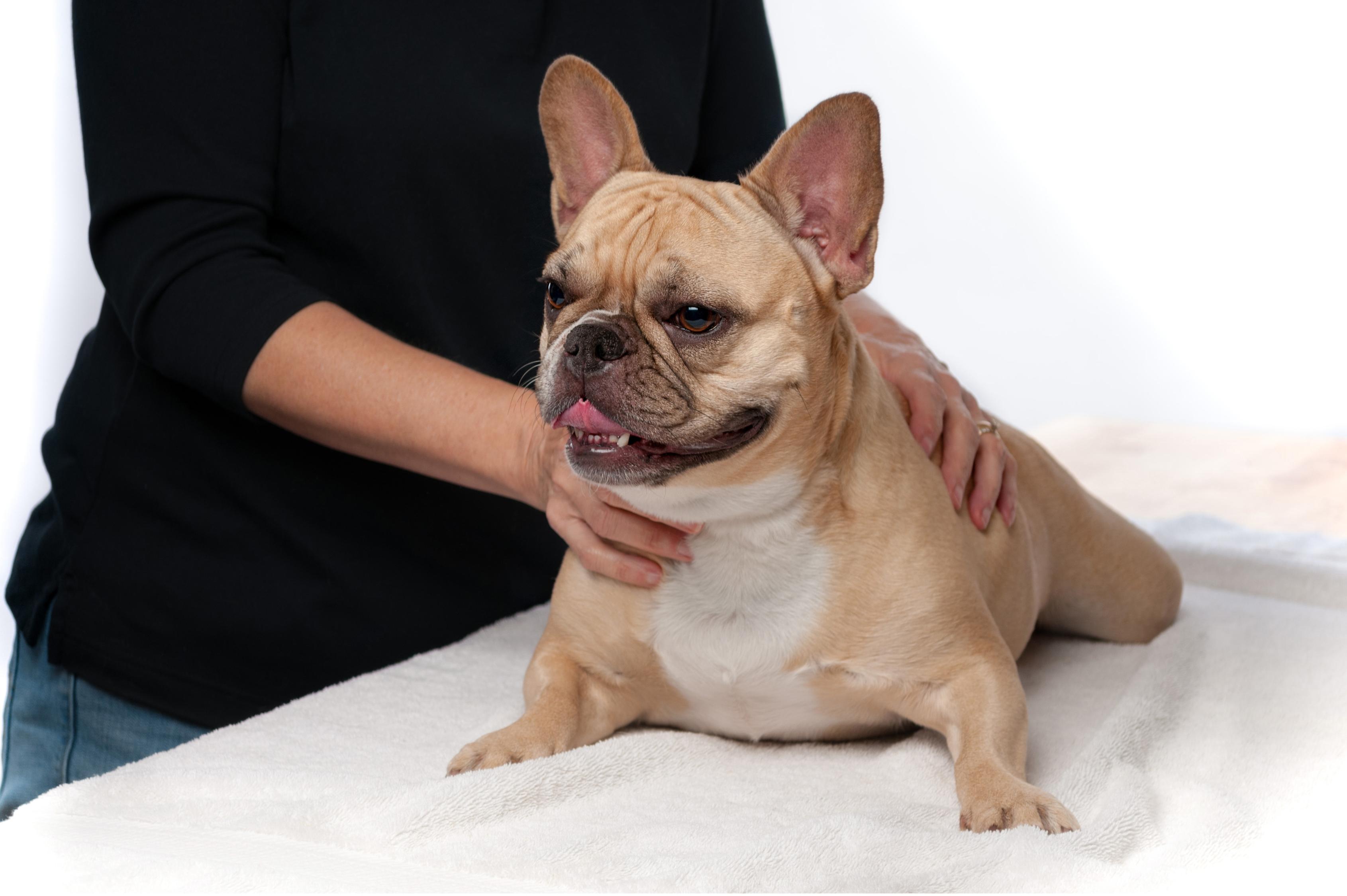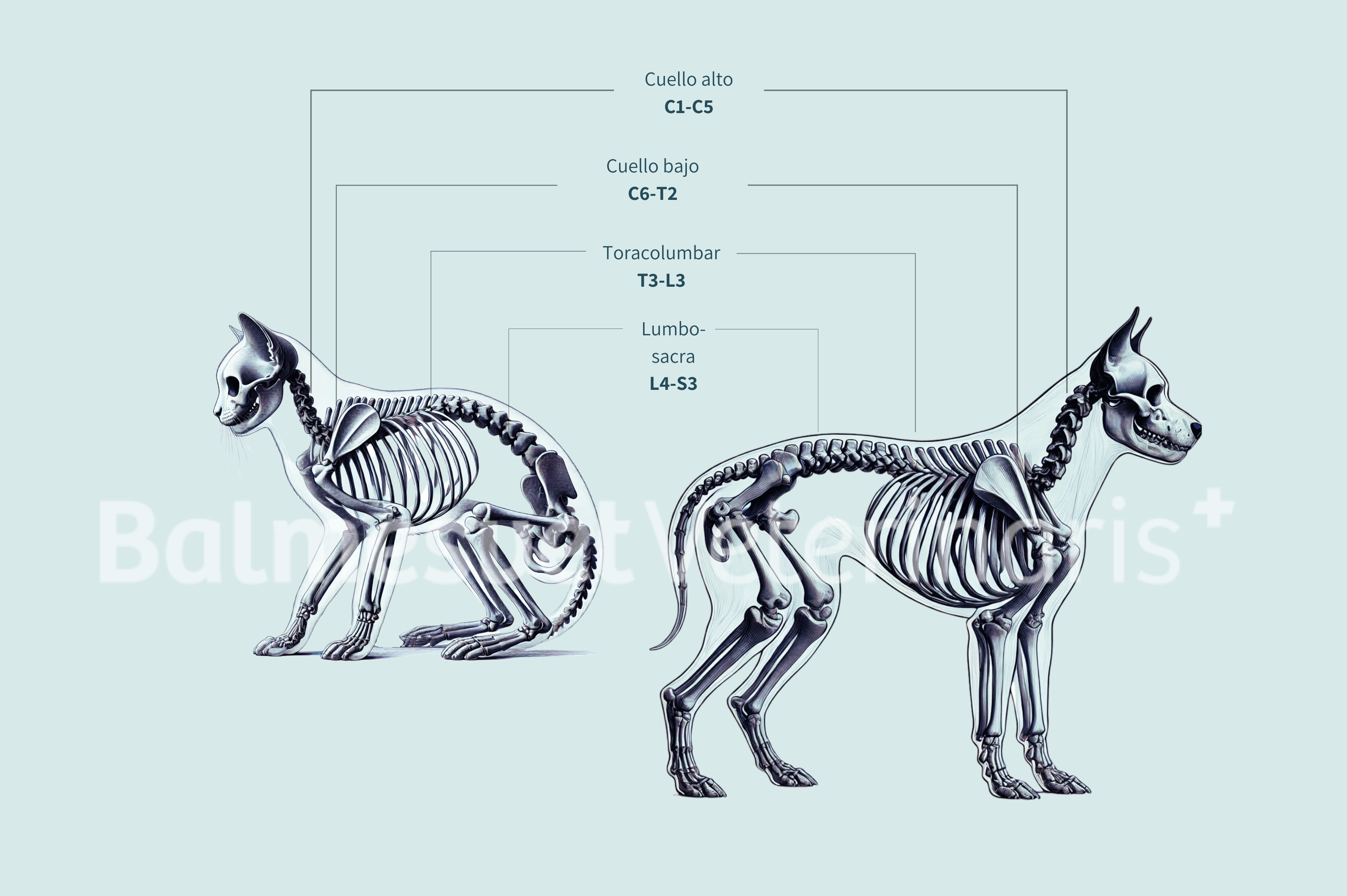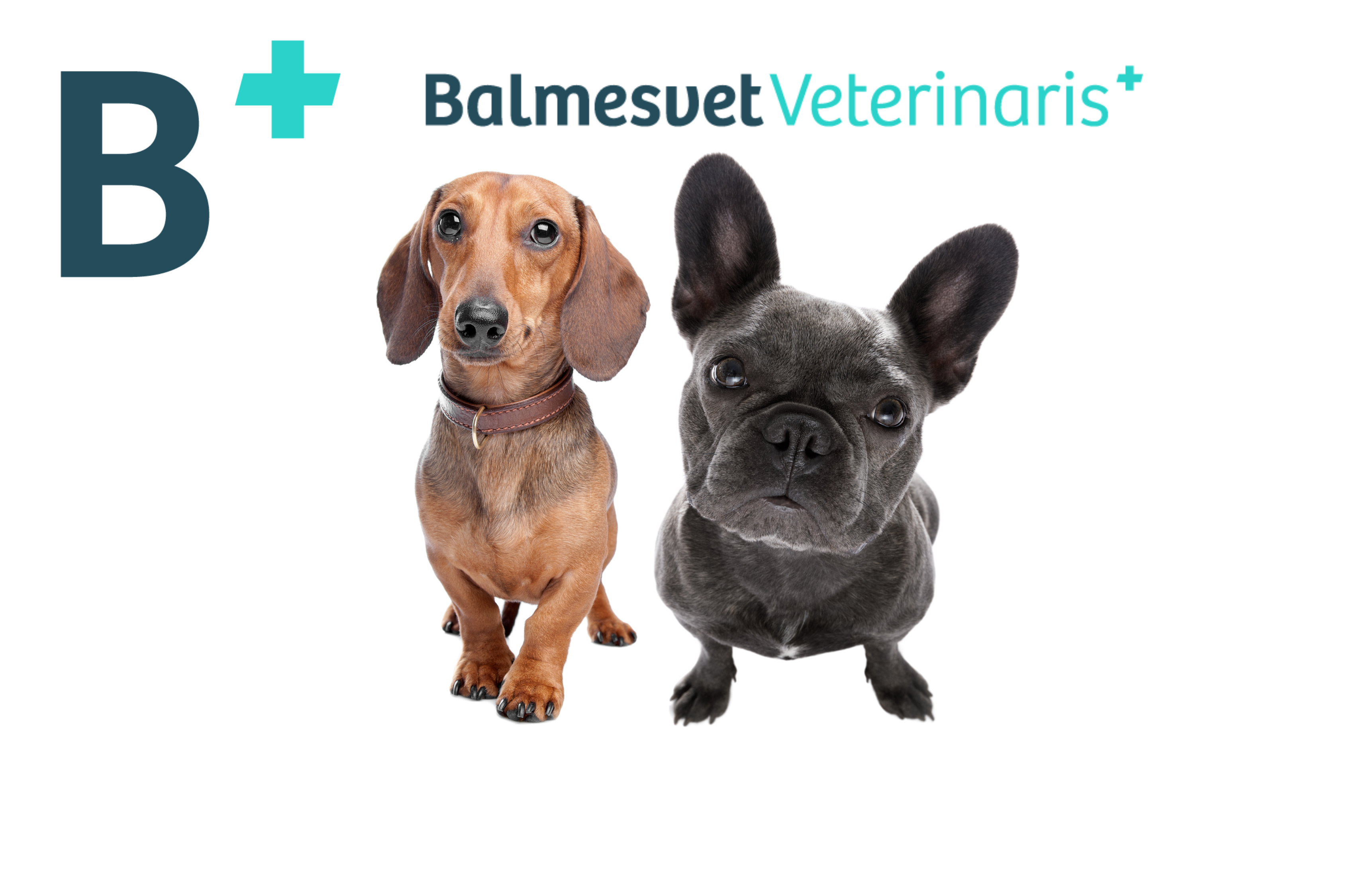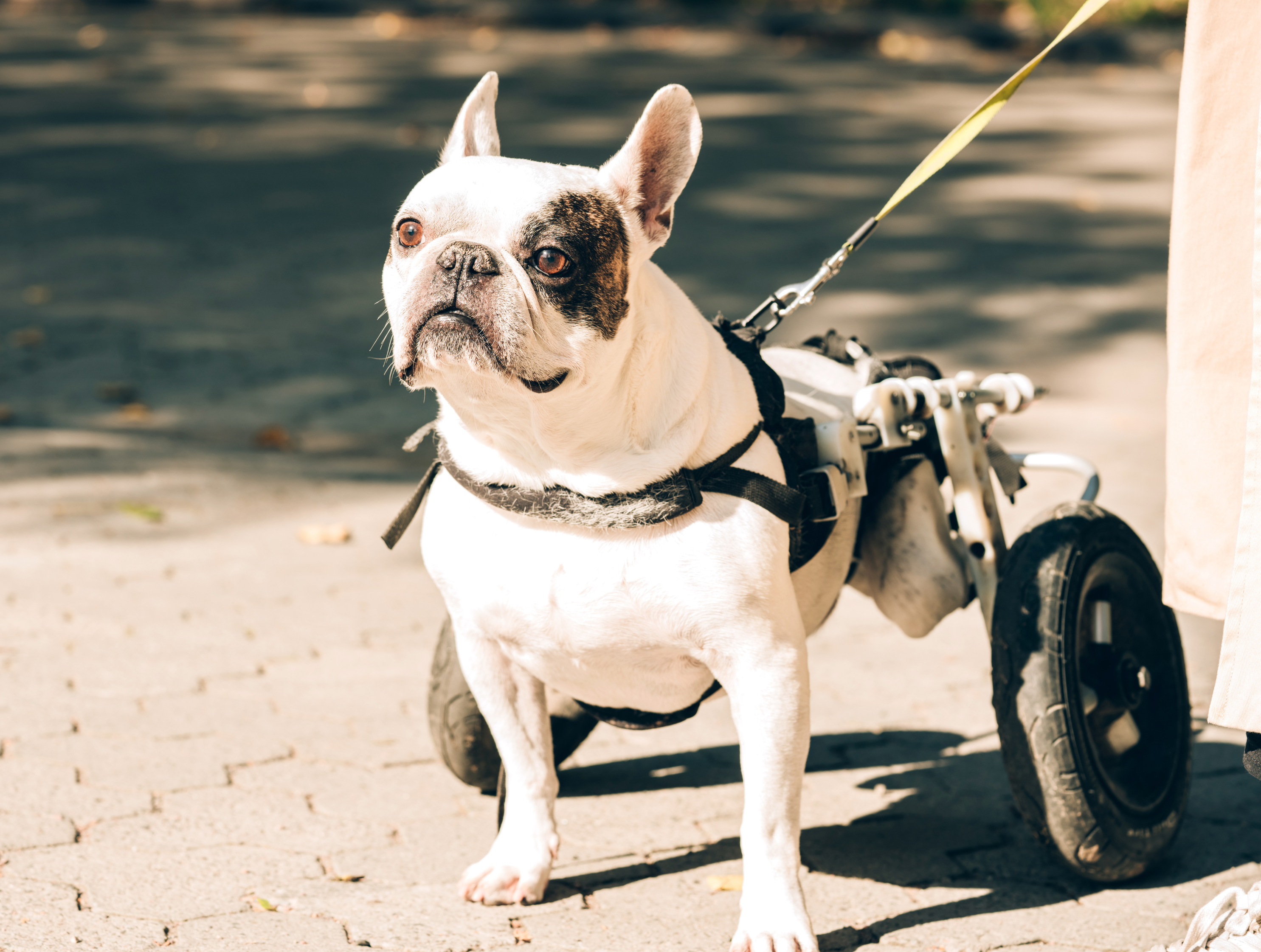Herniated discs are a condition that can affect both cats and dogs, altering their quality of life and causing symptoms ranging from moderate pain to paralysis. In this article, we explain in detail what a herniated disc is, its causes, the most common clinical signs of a herniated disc, the diagnostic tools available and the most effective treatment options. If you are a dog or cat caregiver, this guide will help you identify warning signs and understand how you can take action to protect the health of your feline and canine companion.
What is a herniated disc in dogs and cats?
First we should know that the spinal disc, which is formed by a fibrous disc and a nucleus pulposus, plays a fundamental role in the mobility and stability of the spine. It acts as a shock absorber between the vertebrae, absorbing impacts and allowing flexible movements without damaging the spine. However, when it suffers alterations, it can lead to a pathology known as herniated disc, which affects both cats and dogs.
A herniated disc occurs when part of the spinal disc slips into the spinal canal, causing compression of the spinal cord or nerve roots. This can cause severe pain, difficulty moving and in some cases partial or total paralysis in the canine and feline patient. This condition can severely affect the pulpy quality of life of the cat or dog and needs to be diagnosed and treated early.

Species-specific occurrence and predisposition to herniated discs
- Dogs: herniated discs represent 2.02% of all diagnosed diseases. The most common ones affect the thoracolumbar region.
- Cats: their incidence is lower, 0.12%, being more frequent in the caudal lumbar area.
In dogs, disc degeneration, i.e. progressive wear and tear of the intervertebral disc, is a determining factor predisposing to the development of herniated discs. There are two main types of degeneration:
- Chondroid metaplasia: associated with genetic factors in chondrodystrophic breeds such as Dachsunds or French bulldogs. It is characterized by a loss of the watery content of the nucleus pulposus, starting at 2 months of age.
- Fibroid metaplasia: age-related and seen in all breeds. It involves degeneration of the annulus fibrosus and fibrous collagenization of the nucleus pulposus.
Types of herniated discs in dogs and cats
There are seven types of herniated discs, each with specific clinical and pathophysiological characteristics. These classifications help veterinarians determine the most appropriate treatment for each animal’s situation:
Hansen’s disc herniation type I (disc extrusion)
- What happens: part of the nucleus of the intervertebral disc ruptures and moves into the spinal canal.
- Common breeds: Dachshunds, French bulldogs and other genetically predisposed breeds.
- Symptoms: sudden onset, rapid worsening and severe back pain.
Hansen’s disc herniation type II (disc protrusion)
- What happens: the intervertebral disc protrudes into the vertebral canal without rupturing completely, due to progressive deterioration.
- Common cases: older dogs of any breed.
- Symptoms: slow development, although it may suddenly worsen.
Acute non-compressive nucleus pulposus extrusion
- What happens: by a sudden increase in pressure, the nucleus pulposus is expelled without pressing on the spinal cord.
- Symptoms: rapid onset, but not progressive; less severe than other types.
Acute extrusion of hydrated nucleus pulposus
- What happens: a healthy nucleus suddenly moves into the spinal canal.
- Symptoms: very rapid onset, affecting more on one side of the body (asymmetry).
Intradural/intramedullary extrusion
- What happens: the nucleus of the disc inserts into the spinal cord, causing severe damage.
- Symptoms: paralysis or severe neurological deficits; rare but severe.
Extrusion with extensive epidural bleeding
- What happens: Displacement of the nucleus causes hemorrhage around the spinal cord.
- Symptoms: Severe and rapidly progressive; requires urgent attention.
Traumatic extrusion
- What happens: a severe blow or accident displaces the intervertebral disc.
- Symptoms: severe pain and sudden paralysis; common in falls or trauma.
How to identify spinal problems in your pet

The clinical signs of a herniated disc can vary depending on the severity and location of the injury. Here is a list of the most common symptoms that can help you identify a problem in your cat or dog:
In dogs:
- Changes in posture: arched back or hunched position.
- Difficulty walking: may drag one or more legs.
- Pain when touching certain areas of the back: the dog may whine or try to avoid contact.
- Loss of coordination: clumsy movements or instability.
- Partial or total paralysis: difficulty moving the hind legs or all limbs.
- Incontinence: loss of control of urine or stool.
- Lethargy or decreased activity: the dog may avoid moving for fear of pain.
- Constant barking or whining: related to pain.
- Difficulty defecating: may have trouble adopting proper posture due to pain in the spine or weakness in the hind legs. May also show excessive straining or avoid defecating altogether, leading to constipation.
In cats:
- Difficulty jumping or climbing: especially to high places.
- Reduced physical activity: the cat may prefer to stay still or hide.
- Abnormal walking posture: arched back or stiff movements.
- Unusual vocalizations: pained meows when trying to move or be handled.
- Avoidance of physical contact: especially in the lumbar or back region.
- Problems using the litter box and difficulty defecating: Pain or limited movement may make it difficult for the cat to get in or out of the litter box, leading them to urinate or defecate outside. They may also avoid using it because of discomfort when adopting the posture for defecation, which may cause fecal impaction, excessive straining or constipation.
- Reduced cleanliness: they may stop grooming due to pain.
If you detect any of these signs in your dog or cat, do not hesitate to seek specialized veterinary care immediately. An early evaluation is key to prevent complications and ensure the welfare of your pet. Balmesvet’s Neurology service is focused on diagnosing and treating nervous system problems in dogs and cats, offering specialized and personalized attention. Our team has advanced technology and extensive experience to address common conditions to complex cases, always with the aim of improving the quality of life of your pet..
Degrees of motor impairment in cats and dogs

Motor problems caused by an herniated disc in dogs and cats affects your pet’s ability to move and can vary depending on the location and severity of the injury. Here is a simple explanation of the most common terms:
Paraparesis
- What it is: partial reduction of mobility in the hind legs.
- How it shows up:
-
- Dragging the hind legs.
- Difficulty getting up or walking.
- Unsteady gait, with frequent falls.
Quadriparesis
- What it is: partial reduction of mobility in all four legs.
- How it shows up:
- Generalized weakness or clumsiness.
- Slow, unsteady gait with loss of balance.
- More common in dogs than in cats.
Paraplegia
- What it is: complete loss of motor function in the hind legs.
- How it shows up:
-
- Inability to move or support weight on the hind legs.
- Drags the hind legs to move.
- May have urinary or fecal incontinence.
Tetraplegia (quadriplegia)
- What it is: complete loss of motor function in all four legs.
- How it shows up:
-
- Total inability to move or stand.
- Absence of response to stimuli in the limbs.
- Associated with injuries in the upper cervical region (neck).
Classification according to the location of the herniated disc injury
The severity and symptoms of a herniated disc depend on the region of the spine affected. Here we explain how the injuries are classified and how they affect your pet:
C1-C5 ( upper neck)
- Affects: first cervical vertebrae.
- Symptoms: weakness or paralysis in all four legs, normal or increased reflexes, stiffness and pain in the neck.
C6-T2 ( lower neck)
- Affects: the transition between the neck and the thorax.
- Symptoms: weakness in front legs with diminished reflexes, hind legs with normal or increased reflexes, and difficulty walking.
T3-L3 (thoracolumbar)
- Affects: area between the thorax and abdomen.
- Symptoms: weakness or paralysis in hind legs, normal or increased reflexes and back pain.
L4-S3 (lumbo-sacral)
- Affects: lower back, near the pelvis.
- Symptoms: weakness or paralysis in hind legs, reduced or absent reflexes, urinary incontinence or difficulty defecating.

Diagnosis of herniated disc in dogs and cats: key steps and advanced techniques
The diagnosis of a herniated disc in dogs and cats is done in two main phases:
- Physical examination and taking of medical history: this stage includes the clinical evaluation of the patient and the collection of detailed information provided by the caregivers about the patient’s behavior and the symptoms observed.
- Advanced diagnostic tests: includes the use of imaging techniques to confirm the diagnosis and rule out other conditions.
Identifying that the animal’s problem is of spinal origin and is not related to other conditions that may present similar clinical signs, such as aortic thrombi or hip problems, is the first step in the diagnostic process. This initial step is essential to determining the appropriate treatment and ensuring the welfare of the pacient.
Physical and neurological examination
To confirm the spinal origin, it is essential to perform a thorough examination including:
- Physical and orthopedic examination: allows ruling out other causes of the observed symptoms.
- Neurological examination: this examination should include several key aspects.
- Assessment of the animal’s mental state and behavior.
- Observation of posture and gait.
- Assessment of postural reactions and spinal reflexes.
- Examination of cranial nerves and trunk skin reflex.
- Detection of spinal hyperesthesia (pain on palpation of the spine).
With this data, it is possible to locate the injury in the nervous system. By combining this information with a thorough approach and a detailed anamnesis (information provided by caregivers about recent behavior and symptoms), a list of differential diagnoses can be established.
Imaging tests
Once the initial evaluation has been performed, imaging tests are used to confirm the diagnosis:
- X-rays: these are simple diagnostic tests without the need for general anesthesia. They are therefore useful in patients who have suffered trauma, to have an initial assessment. In them we can see vertebral and bone lesions, and we can see changes indicative of disc herniation, but they do not usually yield a definitive diagnosis.
- Myelography: consists of performing radiographs after administration of contrast in the subarachnoid space under general anesthesia. Based on the contrast lines attenuation or deviation, it allows to classify injuries according to the observed pattern (extradural, intradural, intramedullary/extramedullary, intramedullary). In this method it is possible to locate the damage with greater precision than with simple x-rays. This procedure involves risks derived from the contrast and its application (inflammation and temporary worsening of the condition, convulsions, infection, hemorrhage…).
- CT and myelography CT: they allow to identify disc compressions accurately, with myelography CT (performed after myelography) being particularly useful. It is a short test performed under general anesthesia.
- MRI: is an advanced imaging test that is distinguished by its high accuracy in differentiating all types of herniated discs, as it can assess the state of hydration of the nucleus pulposus. It is performed under general anesthesia, being a test that requires more time to perform.
Is surgical treatment of a herniated disc in dogs and cats always necessary?

There are two main therapeutic approaches depending on the severity of the disc herniation: conservation/medical treatment and surgical treatment.
1. Conservative/medical treatment:
This approach is ideal for less severe cases. It includes:
- Administration of medications:
- Anti-inflammatory drugs to reduce spinal inflammation.
- Analgesics to relieve pain.
- Strict rest:
- The animal should limit their activity for 4 to 6 weeks to avoid aggravating the injury.
- Rehabilitation in specific cases:
- Helps to strengthen muscles and recover mobility.
Main objective:
- Reduce inflammation.
- Allow the annulus fibrosus to heal.
- Facilitate dehydration and resorption of the nucleus pulposus, thus reducing spinal cord compression.
2. Surgical treatment:
This is the recommended approach for more severe cases or when conservation treatment fails.
- Surgical procedures:
- Consists of decompression of the affected spinal cord.
- Techniques vary according to the location and severity of the hernia:
- Ventral Slot.
- Hemilaminectomy.
- Dorsal laminectomy.
- Corpectomy.
- Associated risks:
- Bleeding during surgery.
- Post-surgical infections.
- Iatrogenic spinal cord injury.
- Post-surgical recovery:
- Average recovery time: 2 months, although it can be extended up to 6 months in some cases.
- After the initial rest, rehabilitation is essential for a faster and more complete recovery.
Surgery should always be considered in cases of spinal cord compression, with the exception of acute extrusion of hydrated nucleus pulposus, since it is a non-degenerated disc and will be absorbed over time.
Both approaches require constant veterinary follow-up to assess progress and adjust treatment according to the animal’s needs.
Prognosis of herniated disc in dogs and cats: success and recovery rates according to treatment.

The prognosis depends on the type of hernia and the severity of the clinical signs:
- Spinal pain with ambulatory paraparesis: the success rate of medical treatment is 80%, while surgical treatment is 98%.
- Non-ambulatory paraparesis: medical treatment is 81% successful, while surgical treatment is 93%. However, the degree of recovery with medical treatment is usually lower.
- Paraplegia with profound sensitivity: medical treatment has a 50-60% success rate, while surgical treatment is 93%. In this case, recovery with medical treatment is slower and less complete.
- Paraplegia without severe sensitivity: the success rate of medical treatment is 10-20%, while surgical treatment is 50-60%. It is important to note that surgical success is reduced if more than 48 hours have passed since the onset of symptoms.
In disc protrusions, the success rate of surgical treatment is 70%, compared to the 30% observed with conservation treatment.
Apart from the solution of the condition, it should also be taken into account that herniated discs treated with conservation treatment have a higher percentage of recurrences.
We must not forget that there is a 30% probability of future herniated discs in a patient who has already suffered one.
Prevention of herniated disc in dogs and cats: key tips to reduce risk in cats and dogs
Although it is not possible to completely avoid herniated discs, there are preventive measures that reduce the risk. Maintaining the animal at its ideal weight and encouraging moderate and consistent physical activity are key factors:
- Weight control: essential for reducing the load on the spine.
- Moderate physical activity: avoid explosive or high-impact exercise.
- Chondroprotectors: although they are not effective for intervertebral discs, they are effective for synovial joints.
Neurology Specialty at Balmesvet
Herniated discs are a complex condition that require an accurate diagnosis and personalized treatment to improve the quality of life of affected dogs and cats. At Balmesvet Hospital Veterinari, we have a specialized Neurology service and a highly qualified surgical team. Our hospital is equipped with advanced technology, including a CT scanner in permanent operation, which allows us to make quick and accurate diagnoses in emergency cases.
If you notice any symptoms that may be related to a herniated disc in your cat or dog, do not hesitate to contact us. Call us at 931173173 or send us an email to atencioclient@balmesvet.com.
At Balmesvet, we are committed to offering the best possible care for your pet, because we know that their health is a fundamental part of their happiness and well-being.



